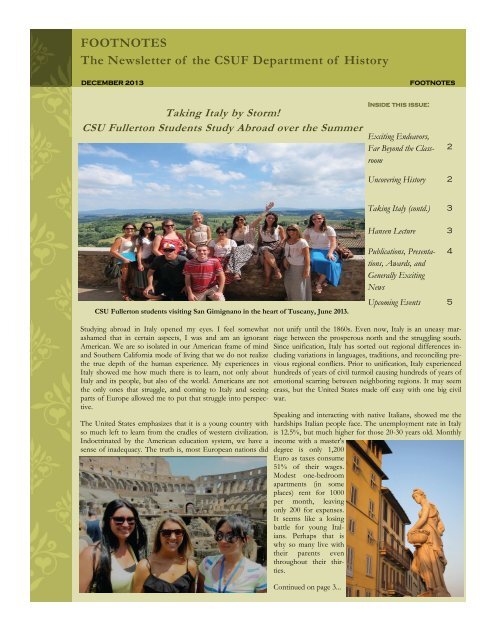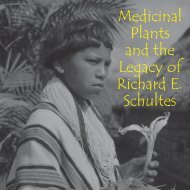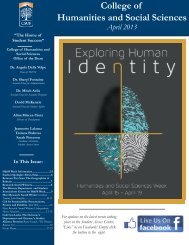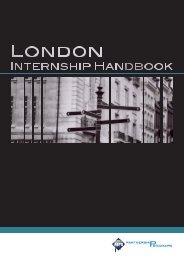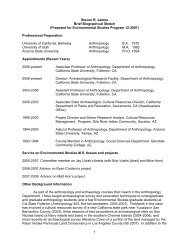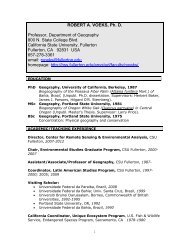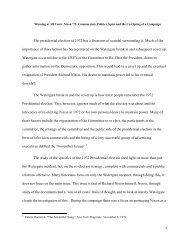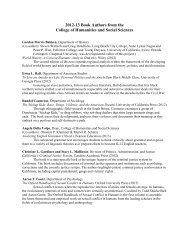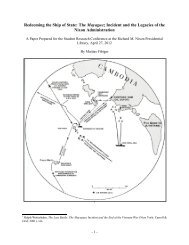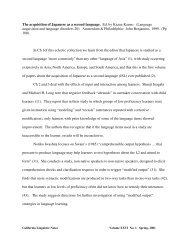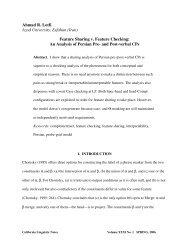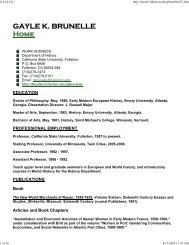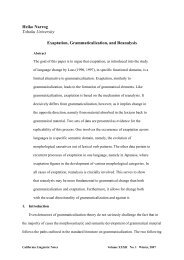Current Newsletter - California State University, Fullerton
Current Newsletter - California State University, Fullerton
Current Newsletter - California State University, Fullerton
Create successful ePaper yourself
Turn your PDF publications into a flip-book with our unique Google optimized e-Paper software.
FOOTNOTESThe <strong>Newsletter</strong> of the CSUF Department of HistoryDECEMBER 2013FOOTNOTESInside this issue:Taking Italy by Storm!CSU <strong>Fullerton</strong> Students Study Abroad over the SummerExciting Endeavors,Far Beyond the Classroom2Uncovering History 2Taking Italy (contd.) 3Hansen Lecture 3CSU <strong>Fullerton</strong> students visiting San Gimignano in the heart of Tuscany, June 2013.Publications, Presentations,Awards, andGenerally ExcitingNews4Upcoming Events 5Studying abroad in Italy opened my eyes. I feel somewhatashamed that in certain aspects, I was and am an ignorantAmerican. We are so isolated in our American frame of mindand Southern <strong>California</strong> mode of living that we do not realizethe true depth of the human experience. My experiences inItaly showed me how much there is to learn, not only aboutItaly and its people, but also of the world. Americans are notthe only ones that struggle, and coming to Italy and seeingparts of Europe allowed me to put that struggle into perspective.The United <strong>State</strong>s emphasizes that it is a young country withso much left to learn from the cradles of western civilization.Indoctrinated by the American education system, we have asense of inadequacy. The truth is, most European nations didnot unify until the 1860s. Even now, Italy is an uneasy marriagebetween the prosperous north and the struggling south.Since unification, Italy has sorted out regional differences includingvariations in languages, traditions, and reconciling previousregional conflicts. Prior to unification, Italy experiencedhundreds of years of civil turmoil causing hundreds of years ofemotional scarring between neighboring regions. It may seemcrass, but the United <strong>State</strong>s made off easy with one big civilwar.Speaking and interacting with native Italians, showed me thehardships Italian people face. The unemployment rate in Italyis 12.5%, but much higher for those 20-30 years old. Monthlyincome with a master'sdegree is only 1,200Euro as taxes consume51% of their wages.Modest one-bedroomapartments (in someplaces) rent for 1000per month, leavingonly 200 for expenses.It seems like a losingbattle for young Italians.Perhaps that iswhy so many live withtheir parents eventhroughout their thirties.Continued on page 3...
FOOTNOTESPage 2Summer Research Endeavors: Exploring WWI Memorial Sites in EuropeThis summer, Itook a thesisresearch trip tosearch for FirstWorld War memorialsto compare.Last summerI saw theBalkans and Germany,but thistime I focusedon the WesternFront. My tightschedule involved some high mileage exploring (20+ mile walks/hikes/runs) and getting “lost” on former battlefields. In the end, Imade it to 6 Unknown Soldier memorials and 22 cities in 21 days.the American Memorial Hospital in Reims. In Verdun, I encountereda unique challenge. The Ossuary had no angle from which I couldcapture all the 13,000 headstones, therefore making the 130,000 unidentifiedremains within the Ossuary more impactful. I then wentonto Metz in the Alsace-Lorraine region, which remembers theFrench as liberators from the Germans. Memorials in Heidelberg andMannheim, Germany, were far more difficult to find than in France.After this, I took a break in Denmark and Sweden before beginningagain in Berlin, Warsaw, and Prague. The locals all over were veryhelpful and provided great insight, perspective, and facts about theircommunities. Although exhausting, the trip proved quite helpful andenlightening.I began in Brussels,then went on toLiege, Ypres, Passendale,and the Germancemetery inLangemark. Fromthere I moved on toFrance to see Arras,Vimy Ridge and itsfantastic Canadianmemorial, Paris, andBy: Steve TakacsSummer Research Endeavors: Defending and Uncovering HistoryOver the summer months, I kept busy bygiving my testimony and uncovering oldpaintings from a local mission.It was last August when I testified on behalfof the Nikkei for Civil Rights/Redress(NCRR) at the Huntington Beach PlanningCommission hearings. The hearings weresuccessful in appealing Rainbow Disposal’sefforts to demolish the Wintersburg Villageon the corner of Warner Avenue and NicholsLane.I spoke about the early Japanese immigrantsbuilding a community until they left for thePoston Relocation Center in Arizona. Next, Iattended a lecture at the Mission San Gabriel.The first presenter was Dr. Natale Zappia,from Whittier College, who discussed earlytrade routes <strong>California</strong> Indians travelled andthe commodities utilized by the many tribes.The second lecturer, Yve Chavez, a Gabrielenoand UCLA doctoral student, discussed thepaintings located in the San Gabriel Mission.In her lecture, she mentioned that there werearound ten to twelve paintings missing orunaccounted for some time. The missingpaintings were in storage under the churchdeteriorating. The painting I am standing nextto is the “Hordes of Hell” and the missionfriars used it as a tool to help convert Indiansto Christianity.By: Tom Fujii
Page 3 VOLUME 1, ISSUE 1Taking Italy by Storm! cont...Regardless, it is Italy was a life-affirming experience.fascinating to Americans constantly complain about oursee how resilientthe Italian My perspective changed extensively.hard luck, but the truth is, we have it easy.people are.Young Americans should go abroad to aEven with backbreakingtaxa-place with a language barrier and get outtion and difficultnational learn to adapt and grow. They can experi-of their comfort zone. That way they canand personal ence the frustration of having so littleobstacles, Italianswhile everything cost so much. Maybe inare still that small way, we can learn to stop takingproud to be the abundance we have for granted. MaybeItalian. They in that small way, we can curb the exceptionalismprevalent in American thoughthave every rightto be. Whether or not Italy is currently in good financial standing, thisand the entitled demeanor that has sweptdoes not overshadow the tremendous accomplishments of the ItalianAmerican youth like a virus. In that way,people, especially during the Renaissance. The masterpieces of art thatI saw, such as the collection in the Vatican, were entirely overwhelming.There was just such an abundance of beauty. Living so close to the others need and learn how to work togeth-we can truly see how others live, whatdome of Santa Maria del Fiore and knowing the history behind its construction,er and facilitate changes. Maybe, if we areleft me in awe of their ingenuity. I lived with buildings and lucky, in that small way, we can be humerexplored buildings hundreds of years old. Call it being a nostalgic historybled.major, but that was amazing. Great people passed through thosebuildings. I got to be there and walk in their footsteps.By: Kaye MaigueHansen Lecture: Harlan County, Kentucky: Thirty Years of Field WorkOn October 8 th the Center for Oral and Public History (COPH) held its 2013 HansenLecture, featuring Alessandro Portelli, professor of American Literature at the Sapienza<strong>University</strong> in Rome, Italy. Professor Portelli presented, "Harlan County, Kentucky: ThirtyYears of Field Work," and spoke to the value and challenges faced by historians collectingoral histories. He is the author of numerous works including: They Say in Harlan County:An Oral History, The Order has Been Carried Out: History, Memory and Meaning of a Nazi Massacrein Rome, and Battle of Valle Giulia: Oral History and the Art of Dialogue.The Hansen Lecture series was created by the Center for Oral and Public History(COPH) in honor of Arthur A. Hansen, CSUF professor emeritus of history and retiredcenter director.
FOOTNOTESPage 4Publications, Presentations, Awards, and Generally Exciting NewsFaculty and staff news: Dr. William W. Haddad, DistinguishedProfessor Emeritus of History, has kindlyagreed to serve as Deputy Chair of theHistory Department for the 2013/2014academic year. Dr. Steve Jobbitt has resigned from thedepartment and moved back to Canada.We wish him well and thank him for all hishard work on behalf of students and facultycolleagues. We will be sure to come andsee him to check on his snow-fort buildingskills. The first episodes of the History Channel’s(H2) “Big History” series, featuring Dr.Jonathan Markley from CSUF’s Departmentof History, are now availableonline:http://www.history.com/shows/big-history. Mr. Ben Perez, a former staff member inour office, has taken a position in theH&SS Dean’s Office. We wish him welland will be sure to come see him in hisnew “digs” on the second floor of theHumanities building. Yan Jie, a visiting scholar from China, willjoin the department to conduct researchnext year.Awards: Dr. Allison Varzally has received an IntramuralResearch Award for her projecttitled “Children of Atonement: VietnameseAdoptees, Wartime Memories and thePolitics of Interracial families.” History M.A. student Jennifer Keil hasreceived an EPOCHS Graduate StudentResearch Fund Award.New publications: Gayle K. Brunelle, “The Assassination ofthe Sieur de Royville and the Debacle ofthe Compagnie de l’Amerique Equinoxial,”TerraeIncognitae 45, no. 2 (2013): 99-112.Jochen Burgtorf, “Der antiochenischeErbfolgekrieg” [“The Antiochene War ofSuccession”], Ordines Militares/ColloquiaTorunensia Historica: Yearbook for the Study ofthe Military Orders 18 (2013): 219-239.Jochen Burgtorf, “The Hospitaller Lordshipof Margat,” in East and West in theMedieval Eastern Mediterranean, Vol . II: Antiochfrom the Byzantine Reconquest until the Endof the Crusader Principality, ed. Krijnie Ciggaarand Victoria van Aalst, OrientaliaLovaniensia Analecta, 199 (Leuven: PeetersPress, 2013), 11-50.William W. Haddad and Jasamin Rostam-Kolayi, “Imperialism and Its Manifestationsin the Middle East,” in The InternationalRelations of the Contemporary Middle East:Subordination and Beyond, ed. Tareq Y.Ismael and Glenn E. Perry (London andNew York: Routledge, 2013), chapter 2.Volker Janssen, “A Tale of Two Crises: AComparative View of the Political Economyof the Great Depression and GreatRecession,” in Sheila Collins and GertrudeGoldberg (eds.),When Government Helped:Learning from the Successes and Failures of theNew Deal. (New York: Oxford <strong>University</strong>Press, 2014).Stephen O’Connor, “The Daily GrainConsumption of Classical Greek Sailorsand Soldiers,” Chiron 43 (2013): 327-356.Past calendar: The “New Graduate Student Orientation”on August 22, 2013, was an exciting, verywell attended event to welcome our newestclass of M.A. students. In attendance were,in addition to the students, two of ourHistory office staff members and six professors. The 2013 Hansen Lecture, featuring Pro-fessor Alessandro Portelli from the Sapienza<strong>University</strong> in Rome, Italy, was a greatsuccess and extremely well attended.Dr. Natalie Fousekis, Dr. Cora Granata,and Dr. Allison Varzally, together withcurrent and former History students KiraGentry, Jennifer Keil, Gloria Lopez , JanetTanner, and Martin Ugelstad, presented atthe National Oral History Associationconference in Oklahoma City in October2013.Dr. Wendy Elliott-Scheinberg presented“An Introduction to Genealogical Research:Sources in Public and <strong>University</strong>Libraries and Archives,” on October 24,2013, in Pollak Library.Dr. Robert McLain presented a lecture onWorld War II on November 12, 2013, atthe <strong>Fullerton</strong> Public Library.The Welebaethan screened the film“Invisible Children” on Thursday, November14, 2013. The goal of this film forumwas to encourage students to write reviewsof the film for submission to the 2014issues of the Welebaethan.Phi Alpha Theta: For the 32 nd year in a row, CSUF’s Theta-Pi Chapter of Phi Alpha Theta (HistoryHonor Society) has received the organization’snationwide “Best Chapter Award,”the Nels A. Cleven Award, awarded to“best chapters” who have won this awardfive or more times, in division VI (in whichthe nation’s largest universities by enrollmentcompete). Nine Phi Alpha Theta students will presentpapers at the society’s 2014 national biennialconference in Albuquerque in January2014: Nicole Arnold, Timothy Barrette,Jason Collar, Matthew Hendricks, LindsayHuysentruyt, Gregory Leighton, Eric Ortega,Madison Pavia-Castro, and Matt Snider.Preserving the Oral Histories of Southern <strong>California</strong>The Los Angeles Times (Monday, September 16, 2013, page A1) featured an article on a woman interviewed by a student from my fall 2012 “FromHitler’s Europe to the Golden <strong>State</strong>” oral history project and class. The article focused on Ilse Byrnes, a Swiss-born 86 year old woman who hasspearheaded the preservationist movement in San Juan Capistrano. The article title is “Past is always present for longtime preservationist.” Her oralhistory is now preserved at CSUF’s Center for Oral and Public History (COPH). The archival citation of the interview is OH 5084, interviewed bystudent Heather Glasgow on November 10, 2012. So, we got her story before the LA Times! Having grown up in Basel, where the town center datesback to the medieval period, Ilse Byrnes now fights to save places that tell <strong>California</strong>’s story. The article can be found at: http://fw.to/I4mxUNmBy: Dr. Cora Granata
FOOTNOTESPage 5Upcoming Events: Save the DateGo For Broke National Education Center and theJapanese American National MuseumOn December 7, 2013 @ 2pm, Veterans of the Military IntelligenceService will discuss their role in the rebuilding of Japan after the end ofWorld War II. Author & retired professor Edwin Nakasone will moderatethe discussion with fellow veterans Bruce Kaji and Hitoshi Sameshima.[A group of Military Intelligence Service students taken during class.]Presented in conjunction with the Eric Saul exhibition:Go For Broke:Japanese American Soldiers Fighting on Two Fronts(November 12, 2013-March 2, 2014)At the Japanese American National Museum in Little TokyoStudent Admission, $5.00 with identificationReservations are highly recommended, email rsvp@janm.org or call213.625.0414Edwin “Bud” Nakasone with his book, The Nisei SoliderIf you have any additional questions please contact:Stacey EllisonExhibits and ProgrammingGo For Broke National Education Centerstacey@goforbroke.orgTHE CSUF HISTORY DEPARTMENT PRESENTS:The History Departmentis excited to invite alumniand other friends ofthe department to joinDr. Stephen O’Connoron a faculty-led tour ofthe Getty Villa on April19, 2014. Dr. O’Connorwill guide alumni andfriends through theGreek exhibits at theVilla and discuss dailylife in peace and war inancient Greece. Pleasecontact Dr. O’Connor(at soconnor@fullerton.edu)formore information and tosign up for the tour(space is limited!)Faculty-led tour of the Getty Villaby Dr. Stephen O'ConnorApril 19, 2014 at 11 am17985 E Pacific Coast Hwy, Pacific Palisades, CA 90272
FOOTNOTESThe <strong>Newsletter</strong> of the CSUF Department of History<strong>California</strong> <strong>State</strong> <strong>University</strong>, <strong>Fullerton</strong>Department of History800 N. <strong>State</strong> College Blvd.<strong>Fullerton</strong>, CA 92834-6846Phone: (657) 278-3474E-mail: raamaro@fullerton.eduThe CSUF History Departmentis on FACEBOOKStay updated and connected:http://www.facebook.com/pages/CSU-<strong>Fullerton</strong>-Department-of-History/133114843454010The History Department’s next annual banquetwill be held on:Friday, April 25, 2014at the Orange County Mining CompanyHave an item for theFebruarynewsletter?Please contactDr. Lynn Sargeant,atlsargeant@fullerton.eduCalling all Alumni, Students, Faculty, andFriends of the Department!The History Departmentneeds you to contribute tothe Department <strong>Newsletter</strong>.Send pictures and shortitems (up to 200 words) thatwould be of interest to thedepartmental communityto: lsargeant@fullerton.edu.


